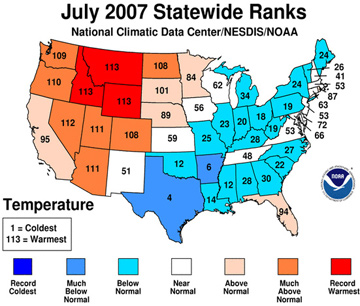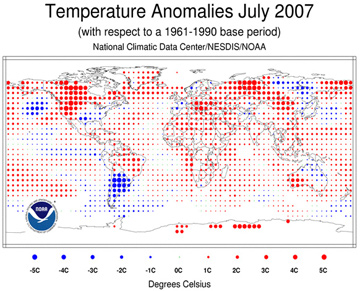July 2007 was the 15th warmest July on record for the U.S.
July 2007 was the 15th warmest July on record for the U.S.
NOAA
August 18, 2007
July 2007 brought record and near-record warmth to the western United States, while much of the eastern and southern U.S. experienced cooler-than-average temperatures, according to scientists at NOAA’s National Climatic Data Center in Asheville, N.C.
Below-average rainfall, combined with scorching temperatures, helped put 46 percent of the contiguous U.S. in some stage of drought by the end of July. The global average temperature was the seventh warmest on record for July, and the presence of cooler-than-average waters in the central and eastern equatorial Pacific reflected the possible development of a La Niña episode.
U.S. Temperature Highlights
|

July 2007 U.S. temperature anomalies. (NOAA)
|
For the contiguous United States, July 2007 was the 15th warmest July since records began in 1895. The monthly mean temperature was 1.4 degrees F (0.8 degrees C) above the 20th century average of 74.3 degrees F (23.5 degrees C).
Twenty states from the eastern seaboard to the Midwest and southern Plains were cooler than average for the month. Florida was the only state warmer-than-average east of the Mississippi.
The persistent atmospheric pattern that brought cooler-than-average temperatures to the East contributed to record and near-record warmth in the West. It was the warmest July on record in Montana, Wyoming and Idaho. Boise, Idaho’s average high temperature of 98.6 degrees F (37 degrees C) was more than 9 degrees F (5 degrees C) above average, and made July 2007 its warmest month ever.
There were 11 days of triple digit temperatures in Missoula, Mont., almost double the previous record of 6 days for the month.
The cooler-than-average July temperatures in the heavily populated eastern U.S. helped push down residential energy needs for the nation as a whole. Using the Residential Energy Demand Temperature Index (REDTI – an index developed at
NOAA to relate energy usage to climate), the nation’s residential energy demand was approximately 4 percentlower than what would have occurred under average climate conditions for the month.
U.S. Precipitation Highlights
|

July 2007 global temperature anomalies. (NOAA)
|
The record warmth and drier-than-average conditions in the northern Rockies led to rapidly worsening drought conditions and helped give the western wildfire season an early and extremely active start. By early August more than 5 million acres had burned in the contiguous U.S, according to the National Interagency Fire Center.
Drought conditions worsened in parts of the northern Rockies, northern Plains, Midwest, and mid-Atlantic. At the end of July, 46 percent of the contiguous U.S. was in moderate-to-exceptional drought, an increase of 12 percent since June. Eighty percent of the Southeast was in drought, with the most severe drought in the nation concentrated in the northern half of Alabama.
July precipitation was near average for the contiguous U.S., but there were sharp contrasts between areas that received above average rainfall and other areas that were drier than average.
It was the third wettest July on record in Texas and Louisiana, the second wettest for the region that includes four neighboring states. The Northeast was also wetter than average along with six western states: Wyoming, Utah, Washington, Oregon, Arizona and California.
Drier-than-average conditions stretched from parts of the mid-Atlantic and Southeast to the Midwest and northern Plains. Rainfall was also below average in Montana, Idaho and Nevada.
Rainfall from the remnants of Hurricane Cosme eased dry conditions on the eastern end of the Big Island of Hawaii, but moderate-to-severe drought continued to affect several of the Hawaiian Islands at the end of July.
Global Highlights
The combined global land and ocean surface temperature was the seventh warmest on record for July. (Click NOAA image for larger view of July 2007 temperature anomalies. Please credit “NOAA.”)
Cooler-than-average ocean surface temperatures in the central and eastern equatorial Pacific reflected the possible development of a La Niña episode and contributed to a global temperature average for July that was lower than recent years.
Although above average temperatures covered most of the world’s land surfaces during July, monthly temperatures were cooler than average in some countries. In much of Argentina, temperatures were more than 5 degrees F (3 degrees C) cooler than average for July, and Buenos Aires had its first major snowfall since 1918.

